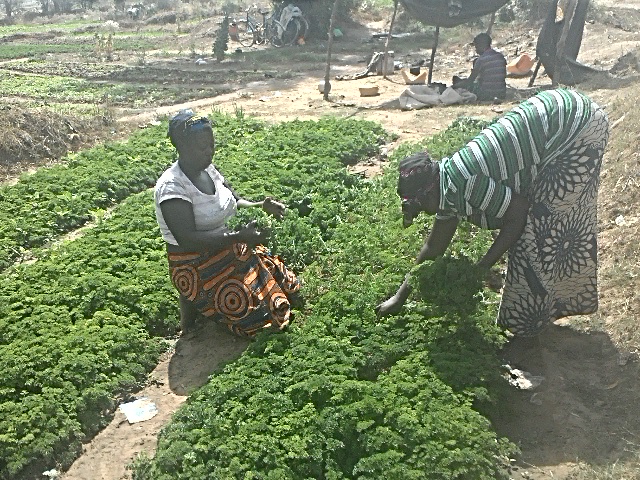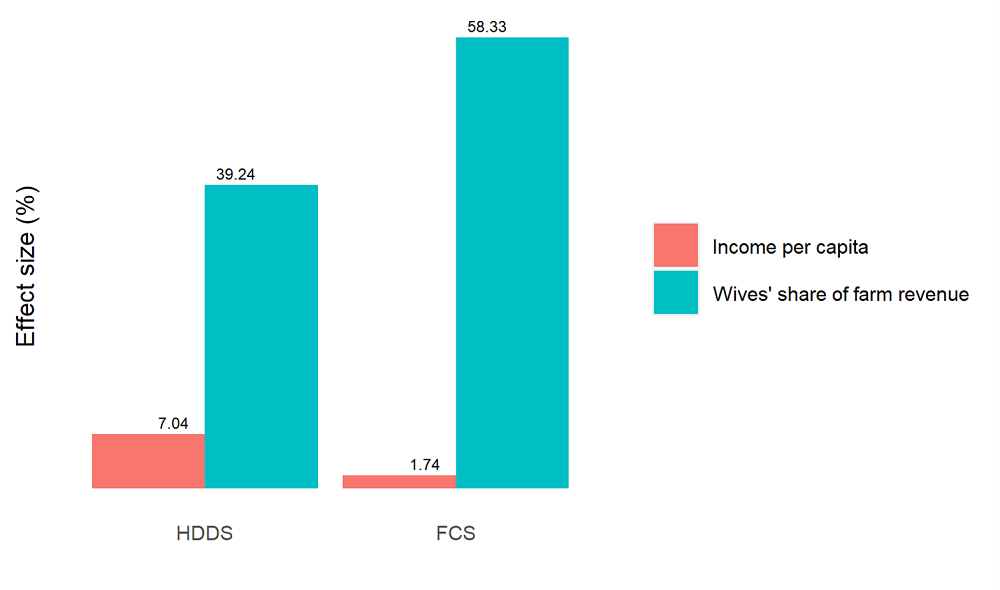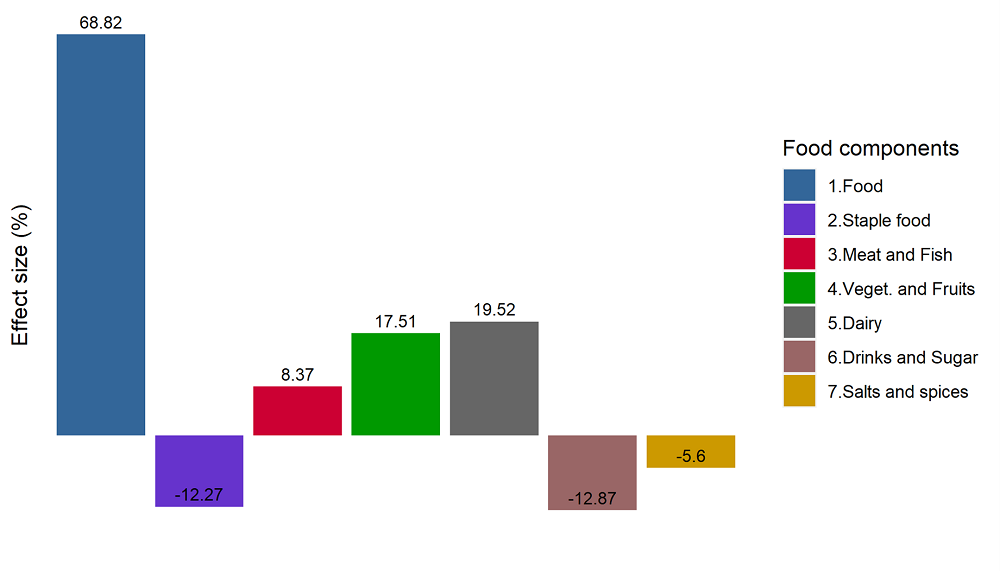IDE Research Columns
Column
Women’s Control over Agricultural Income and Households’ Nutrition Quality: Evidence from Rural Burkina Faso.

R. Apollinaire NIKIEMA
Institute of Developing Economies, JETRO
September 2023
In many developing countries, the revenue from crop sales serves to improves the rural household’s nutrition quality. However, depending on who controls agricultural income, the desired impact may not be realized. Using data collected in rural Burkina Faso, Nikiema and Sakurai (2021) showed that increasing the wives’ share of farm revenue increases food demand and dietary quality. Furthermore, the result shows that the effect size of wives’ share of farm revenue on the quality of nutrition is greater than the household’s per capita income. This suggests that women’s control over agricultural income is important for rural household food and nutrition security.
Link between Agriculture, Gender, and Nutrition
The relationship between agriculture and nutrition is complex and context dependent. First, agriculture improves nutrition by increasing the quantity of food available for home consumption by farm households (Kadiyala et al. 2014). Second, farm households commercialize the surplus of their production and use the cash to purchase non-produce foods (Carletto, Corral, and Guelfi 2017). This is the so-called income pathway of the agriculture and nutrition link (Kadiyala et al. 2014). However, the effectiveness of this route may be contingent on who controls agricultural income. In particular, it is well established that a shift in gender-specific control of income results in a shift in household expenditures. For example, it has been shown that raising women share of income leads to an increase in the proportion of the household budget allocated to food (Armand et al. 2020; Tommasi 2019).
Although many studies have focused on the effect of women’s relative income on household expenditures in general, only a few have examined the effect of women’s control over agricultural income on nutrition. In addition, no causal analysis of the effect of a wife’s share of agricultural income on nutrition has been conducted in existing research. Rather, they examined the correlation between male control over specific crop sales income and household calorie or micronutrient consumption (Fischer and Qaim 2012; Ogutu, Gödecke, and Qaim 2019). In Sub-Saharan Africa, women are increasingly involved in the crop’s commercialization due to the recent development of value chains of semi-cash crops (Njuki et al. 2011). Compared with traditional cash crops, these crops require fewer modern inputs and are easier for women to cultivate, which is an interesting feature. In Nikiema and Sakurai (2021), we contribute to the literature by analyzing the effect of wives’ share of farm income on the dietary diversity of rural Burkina Faso households.
Farm Household Agricultural Production in Burkina Faso
In the majority of Burkina Faso, patriarchy and patrilineage dominate society. As a result, land, the most important productive resource, is concentrated in the hands of men. There are basically two types of plots within farm households in Burkina Faso: the collective plots and the individually managed plots. The head of the household controls the product from the collective plots, whereas the owners of the individually managed plots are free to cultivate the crops of their choice and determine how to utilize the harvest. Moreover, individually managed plots are typically situated on land given by the household’s head. In exchange, each member must first provide labor to the collective and then his own plot.
In Burkina Faso, 80% of population resides in rural areas. Agriculture is the primary source of income for the majority of rural households. In our sample, for instance, over 94% of farm households commercialize a portion of their crops. Furthermore, more than 70% of wives in the sample reported earning cash through crop sales. However, the household cash revenue they control represents less than 16% of the total household cash revenue generated by crop commercialization (Nikiema and Sakurai 2021). This is low considering that women perform up to 52% of agricultural labor in Burkina Faso1.
Wives’ Control over Farm Revenue and Household Dietary Diversity.
In Nikiema and Sakurai (2021), we sought to address the following question: What is the link between the dietary quality of the household and the share of agricultural income held by the wife? First, we found that an increase in a wife’s share of farm revenue is significantly associated with a rise in household food demand and an improvement in dietary quality. For example, a hypothetical 50% shift of farm cash revenue from men to wives would increase the household dietary diversity score (HDDS) and food consumption score (FCS) by 39% and 58%, respectively, relative to the sample means (Figure 1). The effect size is small in the sense that a massive transfer of farmer income to wives2 is required to achieve the minimum level of dietary diversity recommended by experts (FAO & FHI 360 2016).3

Figure 1. Effect Size When Shifting Wives’ Share of Farm Revenue from 0 to 50% on Household Dietary Diversity.
Note: Changes in dietary diversity are expressed as a percentage of the sample mean. The increase in wives’ share of farm revenue from 0 to 50 is equivalent to a cash income of 510,000 CFA for the average household’s wife. For purposes of comparison, we estimate the household dietary diversity score (HDDS) and food consumption score (FCS) for the per capita income to be 510,000 CFA (approximately $856 at the exchange rate on July 12, 2023).
Source: Constructed by the author based on Table 3 from Nikiema and Sakurai (2021).
Furthermore, the results show that the effect size of the per capita income on farm household nutrition is much lower. An equivalent increase in the income per capita4 would cause the HDDS and FCS to rise by only 7.04 % and 1.74%, respectively (Figure 1). This supports previous findings that an increase in income does not necessarily result in a nutritional improvement. Who controls what portion of the total income is significant. Our findings indicate that the effect of wives’ control over agricultural income on nutrition is greater than the effect of total income. This conforms to the studies of previous research. In fact, it has been showed that male control over particular cash crops harms household nutrition (Fisher and Qaim 2012; Ogutu, Gödecke, and Qaim 2019). In our study, we demonstrate not only that wives’ control over cash revenue has a positive effect, but also that increasing wives’ income is the quickest way to improve the nutritional quality of the household.
What Mechanism Is Responsible for the Observed Effects?
To understand how wives’ share of farm income improves household nutrition, we examined the effect of shifting farm income to wives on the proportion of the household budget allocated to the components of food basket (Figure 2). First, the result shows that increasing the wives’ share of agricultural cash income increases the household budget share allocated to food. For instance, increasing the wives’ share of farm income from 0% to 50% would increase the proportion of the budget allocated to food by approximately 69% relative to the sample mean.5 In addition, when different components of the food basket disaggregate this effect, the results show that an increase in the share of farm income accruing to wives induces a shift away from less nutritious food groups and toward more nutritious ones. Figure 2 shows that increasing the wives’ share of farm revenue from 0% to 50% would cause the budget share for fruits and vegetables and meat and fish to increase by 19.5% and 17.5%, respectively, while the budget share for salt and spices and beverages and sugar would decrease by 5.6% and 13.5%, respectively. Following the findings of a recent study by Armand et al. (2020), an increase in the wives’ relative income results in a budget reallocation toward more nutritious food in Mexico. In the vast majority of Sub-Saharan Africa, women are responsible for food preparation and cooking. More cash in women hands allows for greater food selection flexibility. Our findings also shed light on the gender ideologies prevalent in Sub-Saharan Africa, where the provision of food for the family is considered a crucial aspect of good mothering (Hoddinott and Haddad 1995).

Figure 2. Effect Size of a 50% Shift in Farm Income to Wives’ Share on the Budget Share of Food Components.
Note: Changes in dietary diversity are expressed as a percentage of the sample mean.
Source: Author’s construction based on Table 5 in Nikiema and Sakurai (2021).
Policy Implications
Women’s control over income affects the household’s well-being by reallocating funds to alternative expenditures. In Nikiema and Sakurai (2021), we show that an increase in the proportion of farm income controlled by wives is associated with a budget reallocation toward purchasing nutritious foods. Moreover, the impact of the wives’ revenue share exceeds that of the per capita income. Further analysis shows that wives’ share of farm revenue is positively associated with the size and the quality of land they own. Therefore, facilitating women’s access to productive resources, such as land, could be the quickest way for rural households to achieve food and nutritional security.
Author's Note:
This column is based on the following article: Nikiema, Relwendé A., and Takeshi Sakurai. 2021. “Intrahousehold Distribution of Sales Revenue and Household Nutritional Outcomes: What If the Wives Controlled the Farm Revenue?” Agricultural Economics 52 (6): 1029–40. https://doi.org/10.1111/agec.12664.
Notes
- One potential explanation for the limited availability of land is its low productivity. In the majority of Burkina Faso, social norms are patriarchal and patrilineal. As a result, the majority of farmland is controlled by men. In addition, the little lands women have access to is frequently less fertile than land cultivated by men because it receives fewer fallows. Moreover, women have difficulty gaining access to yield-enhancing inputs.
- A change in the wives’ share of farm income from 0% to 50% represents a 300% increase relative to the sample mean.
- FAO and FHI 360 (2016) recommend six food groups as a minimum for dietary diversity. This is the minimum score required to maintain a woman’s health as an adult.
- A shift of wives’ share of farm income from 0% to 50% results in a cash income of 510,000 CFA for the wives. For comparison, we estimate the HDDS and FCS for the per capita income to be 510,000 CFA (approximately $856 as of July 12, 2023 exchange rate).
- This finding is consistent with previous research utilizing data from a cash transfer program targeting mothers in Mexico (Armand et al. 2020; Tommasi 2019). Also, it explains why, despite food being a necessity, the proportion of the budget allocated to food increases with the level of expenditures in certain contexts.
References
Armand, Alex, Orazio Attanasio, Pedro Carneiro, and Valérie Lechene. 2020. “The Effect of Gender-Targeted Conditional Cash Transfers on Household Expenditures: Evidence from a Randomized Experiment.” Economic Journal 130 (631): 1875–97. https://doi.org/10.1093/ej/ueaa056.
Carletto, Calogero, Paul Corral, and Anita Guelfi. 2017. “Agricultural Commercialization and Nutrition Revisited: Empirical Evidence from Three African Countries.” Food Policy 67 (February): 106–18. https://doi.org/10.1016/j.foodpol.2016.09.020.
FAO (Food and Agriculrue Organization of the United Nations) & FHI 360. 2016. “Minimum Dietary Diversity for Women- A Guide to Measurement.” Rome: FAO.
Fischer, Elisabeth, and Matin Qaim. 2012. “Gender, Agricultural Commercialization, and Collective Action in Kenya.” Food Security 4 (3): 441–53. https://doi.org/10.1007/s12571-012-0199-7.
Hoddinott, John, and Lawrence Haddad. 1995. “Does Female Income Share Influence Household Expenditures? Evidence From Côte D’Ivoire.” Oxford Bulletin of Economics and Statistics 57 (1): 77–96. https://doi.org/10.1111/j.1468-0084.1995.tb00028.x.
Kadiyala, Suneetha, Jody Harris, Derek Headey, Sivan Yosef, and Stuart Gillespie. 2014. “Agriculture and Nutrition in India: Mapping Evidence to Pathways.” Annals of the New York Academy of Sciences 1331 (1): 43–56. https://doi.org/10.1111/nyas.12477.
Nikiema, Relwendé A., and Takeshi Sakurai. 2021. “Intrahousehold Distribution of Sales Revenue and Household Nutritional Outcomes: What If the Wives Controlled the Farm Revenue?” Agricultural Economics 52 (6): 1029–40. https://doi.org/10.1111/agec.12664.
Njuki, Jemimah, Susan Kaaria, Angeline Chamunorwa, and Wanjiku Chiuri. 2011. “Linking Smallholder Farmers to Markets, Gender and Intra-Household Dynamics: Does the Choice of Commodity Matter?” European Journal of Development Research 23 (3): 426–43. https://doi.org/10.1057/ejdr.2011.8.
Ogutu, Sylvester Ochieng, Theda Gödecke, and Matin Qaim. 2019. “Agricultural Commercialisation and Nutrition in Smallholder Farm Households.” Journal of Agricultural Economics 71 (2): 534–55. https://doi.org/10.1111/1477-9552.12359.
Tommasi, Denni. 2019. “Control of Resources, Bargaining Power and the Demand of Food: Evidence from PROGRESA.” Journal of Economic Behavior and Organization 161: 265–86. https://doi.org/10.1016/j.jebo.2019.04.008.
Author's Profile:
R. Apollinaire NIKIEMA is a Research Fellow at Institute of Developing Economies, Japan External Trade Organization (IDE-JETRO). He acquired a Ph.D. degree in Agricultural Economics from the University of Tokyo in 2021. His research interests include agricultural markets, food security, and intrahousehold bargaining in Sub-Sahara Africa. Before joining IDE-JETRO, He served as Postdoc at the University of Tokyo and a Monitoring and Evaluation Specialist for the Center for Evaluation and Development (C4ED).
Another Article by This Author:
Nikiema, Relwendé A., Sakiko Shiratori, Jules Rafalimanantsoa, Ryosuke Ozaki, and Takeshi Sakurai. 2023. “How are Higher Rice Yields Associated with Dietary Outcomes of Smallholder Farm Households of Madagascar?” Food Security. 15(3): 823–38. https://doi.org/10.1007/s12571-022-01333-5
* The views expressed in the columns are those of the author(s) and do not represent the views of IDE or the institutions with which the authors are affiliated.
** Thumbnail image: Le Jardin (Tissoufou, CC BY-SA 4.0, via Wikimedia Commons)

